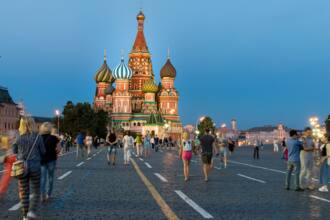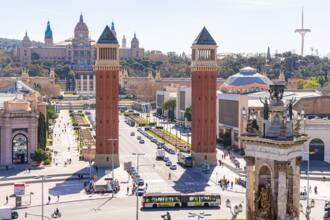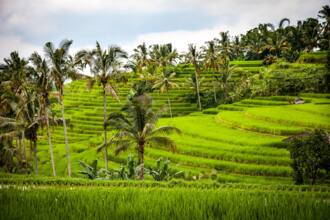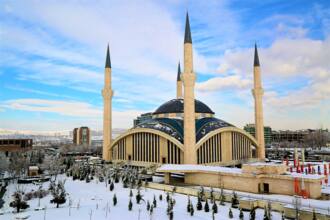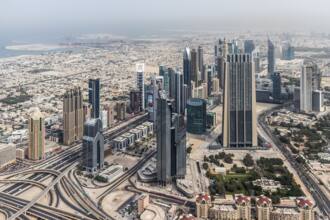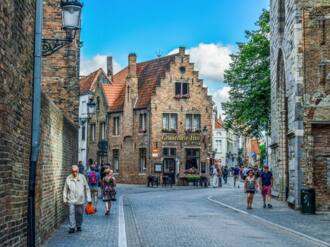The richest countries in the world take pride in their wealth of resources and policies that have enabled them to be at the top of the world. These countries have strong and diverse economies that shield them from collapse and low standards of living. These rich countries are very attractive to migrants and offer great opportunities for their residents.
The richest countries export high-value goods and services from biotechnology, air space equipment, and pharmaceuticals, which have a high return on investment. In this article, we will look at the 25 richest countries in the world by nominal GDP, which is one of the methods of measuring a country’s wealth.
25 richest countries in the world
Here is a list of the richest countries in the world in descending order.
1. United States.
 America is also one of the richest countries in the world, with a GDP of 17.7 trillion dollars and a population of 325 million people with a life expectancy of 78 years. It has a diverse economy comprising of technology, pharmaceuticals, and food products. The country is also home to the richest man in the world.
America is also one of the richest countries in the world, with a GDP of 17.7 trillion dollars and a population of 325 million people with a life expectancy of 78 years. It has a diverse economy comprising of technology, pharmaceuticals, and food products. The country is also home to the richest man in the world.
2. China

China’s GDP is 14.14 trillion dollars. Over the years, the country has registered the growth of its economy owing to its manufacturing capability, technology, and export base. It is slightly close to its big rival, the USA, and it is projected that it could soon surpass America in 2023.
3. Japan

Japan is a wealthy nation with a GDP of 5.15 trillion dollars. It has the third-largest economy in the world and a significant export base as well as a robust manufacturing industry.
4. Germany.
 Germany has one of the largest economies in the world. It has a GDP of 3.8 trillion dollars. There are 82.7 million people with a life expectancy of 81 years. It is also the third-largest exporter of goods after the USA and China. Its biggest export is cars, which account for 12% of all German exports. The industry manufactures BMW’s Audi and Volkswagen. The nation boasts of having one of the best F1 drivers in the world.
Germany has one of the largest economies in the world. It has a GDP of 3.8 trillion dollars. There are 82.7 million people with a life expectancy of 81 years. It is also the third-largest exporter of goods after the USA and China. Its biggest export is cars, which account for 12% of all German exports. The industry manufactures BMW’s Audi and Volkswagen. The nation boasts of having one of the best F1 drivers in the world.
5. India

This Asian nation has a GDP of 2.94 trillion dollars. India has a population of one billion people, which decreases its GDP per capita. There is still a large number of people who live in poverty. That said, the country gets its wealth from manufacturing industries and a reliable service sector.
6. United Kingdom
 The country has a GDP of 2.83 trillion dollars. Its economy is driven by a strong services sector, manufacturing, and agriculture.
The country has a GDP of 2.83 trillion dollars. Its economy is driven by a strong services sector, manufacturing, and agriculture.
7. France
 France has a GDP of 2.6 trillion. Its population includes 67 million people with a life expectancy of 82 years. It is a wealthy country owing to exports worth 500 billion dollars. Exports include automobiles, aerospace equipment, and wine.
France has a GDP of 2.6 trillion. Its population includes 67 million people with a life expectancy of 82 years. It is a wealthy country owing to exports worth 500 billion dollars. Exports include automobiles, aerospace equipment, and wine.
8. Italy
 This European nation has a GDP of 1.99 trillion dollars. Its economy is driven by a big export base and business investments locally and internationally.
This European nation has a GDP of 1.99 trillion dollars. Its economy is driven by a big export base and business investments locally and internationally.
9. Brazil

The largest country in South America has a GDP of 1.85 trillion dollars. Brazil is endowed with natural resources like tin, iron ore, and other minerals, which have helped drive the economy upwards.
10. Canada

The country has a GDP of 1.73 trillion dollars and a population of 36.7 million people with a life expectancy of 82 years. It is a large exporter of crude oil behind Saudi Arabia and Iraq. The oil accounts for a large percentage of the country’s total export value.
11. Russia

The country has a GDP of 1.64 trillion dollars. In the 1990s, its economy witnessed a commodity boom from the industrial and agricultural sectors. Other than that, the country has also made wealth through oil. The country has also garnered acclaim for being among the first to produce a Covid 19 vaccine.
12. South Korea

This Asian giant has a GDP of 1.63 trillion dollars. It is known for its robust technology with the manufacture of Samsung and Hyundai. Its economy is driven by trade and industrialization.
13. Spain
 With a GDP of 1.4 trillion dollars, Spain boasts of a large service sector as it receives many tourists, agriculture with exports like olive oil and wine, pharmaceuticals, and machinery.
With a GDP of 1.4 trillion dollars, Spain boasts of a large service sector as it receives many tourists, agriculture with exports like olive oil and wine, pharmaceuticals, and machinery.
14. Australia
 Australia has a GDP of 1.38 trillion dollars and a population of 24.6 million people with a life expectancy of 82 years. The country produces a lot of iron and is the world’s largest producer of the minerals. Iron is highly consumed in the world market and offers great investment returns, thus making Australia a rich country.
Australia has a GDP of 1.38 trillion dollars and a population of 24.6 million people with a life expectancy of 82 years. The country produces a lot of iron and is the world’s largest producer of the minerals. Iron is highly consumed in the world market and offers great investment returns, thus making Australia a rich country.
15. Mexico
 The South American nation has a GDP of 1.22 trillion dollars. The economy here is driven by oil exports, electronics, automotive, tourism, and financial services.
The South American nation has a GDP of 1.22 trillion dollars. The economy here is driven by oil exports, electronics, automotive, tourism, and financial services.
16. Indonesia
 With a GDP of 1.11 trillion dollars, this Asian country has managed to be among the top 25 wealthiest countries. The economy here is driven by agriculture and a strong industrial sector.
With a GDP of 1.11 trillion dollars, this Asian country has managed to be among the top 25 wealthiest countries. The economy here is driven by agriculture and a strong industrial sector.
17. Netherlands

This is a wealthy European country with a GDP of 835.8 billion dollars with a population of 17.1 million and a life expectancy of 81 years. Its main exports include horticulture and medical technologies.
18. Saudi Arabia

This is one of the richest countries in the Arab world, owing to oil resources. It has a GDP of 779.2 billion, with a population of 32.9 million, and a life expectancy of 74 years. It is the largest exporter of crude oil in the world. This country is a monarchy.
19. Turkey
 With a GDP of 743.7 billion dollars, this middle eastern nation has managed to call itself wealthy owing to big industries and services.
With a GDP of 743.7 billion dollars, this middle eastern nation has managed to call itself wealthy owing to big industries and services.
20. Switzerland

Switzerland has a GDP of 715.3 billion dollars and a population of 8.5 people with a life expectancy of 83 years. Its source of wealth is gold, which holds the largest share of its exports. The country’s economic backbone is innovation as it invests a large amount of GDP on research and development.
21. United Arab Emirates
 This country has a GDP of 632.6 billion dollars, with a population of 9.4 million people and a life expectancy of 77 years. UAE gets its wealth from exports of crude oil, gas, gold, and diamonds, making it one of the top richest countries in the world. It has one of the lowest unemployment rates in the world.
This country has a GDP of 632.6 billion dollars, with a population of 9.4 million people and a life expectancy of 77 years. UAE gets its wealth from exports of crude oil, gas, gold, and diamonds, making it one of the top richest countries in the world. It has one of the lowest unemployment rates in the world.
22. Sweden
 This country has a GDP of 528.9 billion dollars, a population of 10.1 million, and a life expectancy of 82 years. Its most considerable investment is education. As a result, the country has the highest primary school enrollment, and its residents are well educated.
This country has a GDP of 528.9 billion dollars, a population of 10.1 million, and a life expectancy of 82 years. Its most considerable investment is education. As a result, the country has the highest primary school enrollment, and its residents are well educated.
23. Belgium
 Belgium has a GDP of 517 billion dollars and a population of 11.4 million people. The life expectancy here is 81 years, an indication of high standards of living. It is a big exporter of goods, which account for more than 85% of its GDP. Its wealth is gained from medicine, petroleum, diamonds, and cars.
Belgium has a GDP of 517 billion dollars and a population of 11.4 million people. The life expectancy here is 81 years, an indication of high standards of living. It is a big exporter of goods, which account for more than 85% of its GDP. Its wealth is gained from medicine, petroleum, diamonds, and cars.
24. Singapore
 This Asian nation connects mainland Asia to the rest of the world. It has a GDP of 340 billion dollars, with a population of 5.6 million people and a life expectancy of 82 years. The country is the largest seller of microchips and other technologies, which make up 36% of its exports. Singapore is open to much of the world, given it has visa-free accessibility.
This Asian nation connects mainland Asia to the rest of the world. It has a GDP of 340 billion dollars, with a population of 5.6 million people and a life expectancy of 82 years. The country is the largest seller of microchips and other technologies, which make up 36% of its exports. Singapore is open to much of the world, given it has visa-free accessibility.
25. Qatar
 Qatar is one of the richest countries globally. It is located in the Middle East, in the Arabian Peninsula. It has a GDP of 183 billion dollars, making it the richest country in the world. It has a total population of 2.6 million people living up to 78 years. Qatar gets its wealth from oil reserves that are the backbone of its economy.
Qatar is one of the richest countries globally. It is located in the Middle East, in the Arabian Peninsula. It has a GDP of 183 billion dollars, making it the richest country in the world. It has a total population of 2.6 million people living up to 78 years. Qatar gets its wealth from oil reserves that are the backbone of its economy.
The richest countries export high-value goods and services from biotechnology, air space equipment, and pharmaceuticals, which have a high return on investment. In this article, we will look at the 25 richest countries in the world by nominal GDP, which is one of the methods of measuring a country’s wealth.
25 richest countries in the world
Here is a list of the richest countries in the world in descending order.
1. United States.
2. China
China’s GDP is 14.14 trillion dollars. Over the years, the country has registered the growth of its economy owing to its manufacturing capability, technology, and export base. It is slightly close to its big rival, the USA, and it is projected that it could soon surpass America in 2023.
3. Japan
Japan is a wealthy nation with a GDP of 5.15 trillion dollars. It has the third-largest economy in the world and a significant export base as well as a robust manufacturing industry.
4. Germany.
5. India
This Asian nation has a GDP of 2.94 trillion dollars. India has a population of one billion people, which decreases its GDP per capita. There is still a large number of people who live in poverty. That said, the country gets its wealth from manufacturing industries and a reliable service sector.
6. United Kingdom
7. France
8. Italy
9. Brazil
The largest country in South America has a GDP of 1.85 trillion dollars. Brazil is endowed with natural resources like tin, iron ore, and other minerals, which have helped drive the economy upwards.
10. Canada
The country has a GDP of 1.73 trillion dollars and a population of 36.7 million people with a life expectancy of 82 years. It is a large exporter of crude oil behind Saudi Arabia and Iraq. The oil accounts for a large percentage of the country’s total export value.
11. Russia
The country has a GDP of 1.64 trillion dollars. In the 1990s, its economy witnessed a commodity boom from the industrial and agricultural sectors. Other than that, the country has also made wealth through oil. The country has also garnered acclaim for being among the first to produce a Covid 19 vaccine.
12. South Korea
This Asian giant has a GDP of 1.63 trillion dollars. It is known for its robust technology with the manufacture of Samsung and Hyundai. Its economy is driven by trade and industrialization.
13. Spain
14. Australia
15. Mexico
16. Indonesia
17. Netherlands
This is a wealthy European country with a GDP of 835.8 billion dollars with a population of 17.1 million and a life expectancy of 81 years. Its main exports include horticulture and medical technologies.
18. Saudi Arabia
This is one of the richest countries in the Arab world, owing to oil resources. It has a GDP of 779.2 billion, with a population of 32.9 million, and a life expectancy of 74 years. It is the largest exporter of crude oil in the world. This country is a monarchy.
19. Turkey
20. Switzerland
Switzerland has a GDP of 715.3 billion dollars and a population of 8.5 people with a life expectancy of 83 years. Its source of wealth is gold, which holds the largest share of its exports. The country’s economic backbone is innovation as it invests a large amount of GDP on research and development.
21. United Arab Emirates
22. Sweden
23. Belgium
24. Singapore
25. Qatar

